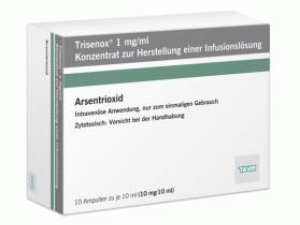三氧化二砷,三氧化二砷注射剂TRISENOX injection 2mg/6mL(ARSENIC TRIOXIDE )
 药店国别:无
产地国家:美国
处方药:是
所属类别: 2毫克/6毫升/瓶 10瓶/盒
包装规格: 2毫克/6毫升/瓶 10瓶/盒
计价单位:盒
生产厂家中文参考译名:无
生产厂家英文名:CEPHALON INC
原产地英文商品名:TRISENOX 2MG/ML 6ML AMP 10/PAC
原产地英文药品名:ARSENIC TRIOXIDE
中文参考商品译名:TRISENOX注射剂 2毫克/6毫升/瓶 10瓶/盒
中文参考药品译名:三氧化二砷
曾用名:无
药店国别:无
产地国家:美国
处方药:是
所属类别: 2毫克/6毫升/瓶 10瓶/盒
包装规格: 2毫克/6毫升/瓶 10瓶/盒
计价单位:盒
生产厂家中文参考译名:无
生产厂家英文名:CEPHALON INC
原产地英文商品名:TRISENOX 2MG/ML 6ML AMP 10/PAC
原产地英文药品名:ARSENIC TRIOXIDE
中文参考商品译名:TRISENOX注射剂 2毫克/6毫升/瓶 10瓶/盒
中文参考药品译名:三氧化二砷
曾用名:无
简介
近日,美国食品药物监督管理局批准了一种新的治疗急性白血病(APL)的药物,该药从研制到被批准的速度之快是很少见的。Trisenox 在美国,从研究到被批准用了3年时间。 该药对于使用其他药物无效的白血病患者很有帮助。在40名应用Trisenox治疗的患者中,28名患者(70%)获治愈。治愈的平均时间为51天。急性白血病(APL)是一种白血细胞恶性肿瘤。患者骨髓和血液中的白血细胞迅速增加。 这个结果导致,贫血,易感染,出血。据估计,每年有1500名新的急性白血病病例发生。有400名患者对于一线疗法不敏感或发生复发。 Trisenox中的活性物质是三氧化二砷。它可以将癌变的白血细胞转变成正常白血细胞。砷制剂疗法早已用于治疗白血病,但已被现代的化疗方法和抗生素治疗所代替。 批准日期:2000年9月 公司:梯瓦(Teva)TRISENOX(三氧化二砷[arsenic trioxide])注射液,用于静脉注射 美国最初批准:2000年 警告: 分化综合症和心脏传导异常查看完整的盒装警告的完整处方信息。 •接受TRISENOX治疗的患者可能会出现分化综合症,这可能是致命的。如果出现症状,立即启动高剂量类固醇并监测血流动力学。 •TRISENOX可引起QT间期延长和室性心律失常,这可能是致命的。在给予TRISENOX之前,评估QT间期,纠正电解质异常,并考虑停用已知toprolong QT间期的药物。不要给患有心室性心律失常或长期QTcF的患者服用TRISENOX。 最近的重大变化适应症和用法:01/2018 剂量和用法:01/2018 警告和注意事项:01/2018 作用机制 TRISENOX的作用机制尚不完全清楚。 三氧化二砷引起细胞凋亡的形态变化和DNA断裂特征在NB4人类早幼粒细胞白血病细胞体外。三氧化二砷还引起融合蛋白早幼粒细胞白血病(PML) - 视黄酸受体(RAR)-α的损伤或降解。 适应症和用法 TRISENOX是一种砷化学品: •与维甲酸联合用于治疗患有新诊断的低风险早幼粒细胞白血病(APL)的成人,其APL的特征在于存在t(15; 17)易位或PML/RAR-α基因表达。 •用于诱导APL患者的缓解和巩固,这些患者因类维生素A和蒽环类化疗难以治愈或复发,且其APL特征在于存在t(15; 17)易位或PML/RAR-α基因表达。 剂量和给药 新诊断的低风险APL: •诱导:每天静脉注射0.15mg/kg与维甲酸组合,直至骨髓缓解。感应不要超过60天。 •巩固:每周5天静脉注射0.15mg/kg,在8周周期的第1-4周内,与维甲酸组合使用共4个周期。复发或难治性APL: •诱导:每天静脉注射0.15mg/kg,直至骨髓缓解。注意60剂量的总诱导。 •巩固:每天静脉注射0.15mg/kg,连续25次,最多5次周。 剂量形式和强度注射:在单剂量小瓶中,在6mL中加入12mg三氧化二砷。 禁忌症:对砷过敏。 警告和注意事项 •肝毒性:用TRISENOXin联合维甲酸治疗新诊断的低危或中度风险APL患者,肝转氨酶升高≥3级。在TRISENOX治疗期间,每周至少监测两次肝功能检查。 •致癌作用:三氧化二砷是一种人类致癌物质。监测患者的第二原发恶性肿瘤的发展。 •胚胎 - 胎儿毒性:可能导致胎儿伤害。建议对胎儿有潜在风险和使用有效避孕措施。 不良反应 最常见的不良反应(大于30%)是白细胞增多,中性粒细胞减少,血小板减少,恶心,呕吐,腹泻,腹痛,肝毒性,发烧,严酷,疲劳,失眠,心动过速,QTc延长,水肿,高血糖,低钾血症,低镁血症,呼吸困难,咳嗽,皮疹或瘙痒,喉咙痛,关节痛,头痛,感觉异常和头晕。 用于特定人群 •哺乳期:建议女性不要母乳喂养。 •肾功能损害:用TRISENOX治疗时,监测严重肾功能不全(肌酐清除率低于30mL/min)的患者的毒性;剂量减少可能是有道理的。 •肝功能损害:用TRISENOX治疗严重肝功能损害患者(Child-PughClass C)的毒性。 如何提供/存储和处理 如何提供TRISENOX(三氧化二砷)注射液以10mL玻璃单剂量小瓶的无菌透明无色溶液形式提供。NDC 63459-601-06 12毫克/6毫升(2毫克/毫升)小瓶,装在10个小瓶中。存储和处理储存在20°-25°C(68°-77°F); 允许偏移15°-30°C(59°- 86°F)(见USP受控室温)。 不要冻结。TRISENOX是一种细胞毒性药物。 遵循适用的特殊处理和处理程序。 英文版说明 trisenox-prescribing-information.pdfWARNINGExperienced Physician and Institution:TRISENOX® (arsenic trioxide) injection should be administered under the supervision of a physician who is experienced in the management of patients with acute leukemia.APL Differentiation Syndrome:Some patients with APL treated with TRISENOX have experienced symptoms similar to a syndrome called the retinoic-acid-acute promyelocytic leukemia (RA-APL) or APL differentiation syndrome, characterized by fever, dyspnea, weight gain, pulmonary infiltrates and pleural or pericardial effusions, with or without leukocytosis. This syndrome can be fatal. The management of the syndrome has not been fully studied, but high-dose steroids have been used at the first suspicion of the APL differentiation syndrome and appear to mitigate signs and symptoms. At the first signs that could suggest the syndrome (unexplained fever, dyspnea and/or weight gain, abnormal chest auscultatory findings or radiographic abnormalities), high-dose steroids (dexamethasone 10 mg intravenously BID) should be immediately initiated, irrespective of the leukocyte count, and continued for at least 3 days or longer until signs and symptoms have abated. The majority of patients do not require termination of TRISENOX therapy during treatment of the APL differentiation syndrome.ECG Abnormalities:Arsenic trioxide can cause QT interval prolongation and complete atrioventricular block. QT prolongation can lead to a torsade de pointes-type ventricular arrhythmia, which can be fatal. The risk of torsade de pointes is related to the extent of QT prolongation, concomitant administration of QT prolonging drugs, a history of torsade de pointes, pre-existing QT interval prolongation, congestive heart failure, administration of potassium-wasting diuretics, or other conditions that result in hypokalemia or hypomagnesemia. One patient (also receiving amphotericin B) had torsade de pointes during induction therapy for relapsed APL with arsenic trioxide.ECG and Electrolyte Monitoring Recommendations:Prior to initiating therapy with TRISENOX, a 12-lead ECG should be performed and serum electrolytes (potassium, calcium, and magnesium) and creatinine should be assessed; pre-existing electrolyte abnormalities should be corrected and, if possible, drugs that are known to prolong the QT interval should be discontinued. For QTc greater than 500 msec, corrective measures should be completed and the QTc reassessed with serial ECGs prior to considering using TRISENOX. During therapy with TRISENOX, potassium concentrations should be kept above 4 mEq/L and magnesium concentrations should be kept above 1.8 mg/dL. Patients who reach an absolute QT interval value > 500 msec should be reassessed and immediate action should be taken to correct concomitant risk factors, if any, while the risk/benefit of continuing versus suspending TRISENOX therapy should be considered. If syncope, rapid or irregular heartbeat develops, the patient should be hospitalized for monitoring, serum electrolytes should be assessed, TRISENOX therapy should be temporarily discontinued until the QTc interval regresses to below 460 msec, electrolyte abnormalities are corrected, and the syncope and irregular heartbeat cease. There are no data on the effect of TRISENOX on the QTc interval during the infusion.用药温馨提示:当您服用此药物时,需定期接受医疗专业人士的检查,以便随时针对其药效、副作用等情况进行监测。本网站所包含的信息旨在为患者提供帮助,不能代替医学建议和治疗。
药品价格查询,专业药品查询网站,药品说明书查询,药品比价 » 三氧化二砷,三氧化二砷注射剂TRISENOX injection 2mg/6mL(ARSENIC TRIOXIDE )
药品价格查询,专业药品查询网站,药品说明书查询,药品比价 » 三氧化二砷,三氧化二砷注射剂TRISENOX injection 2mg/6mL(ARSENIC TRIOXIDE )


